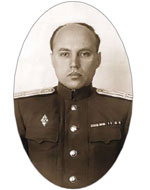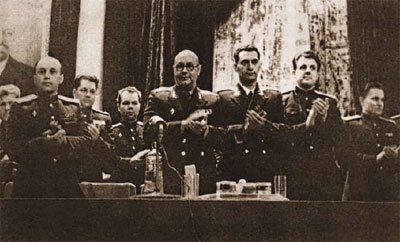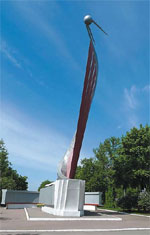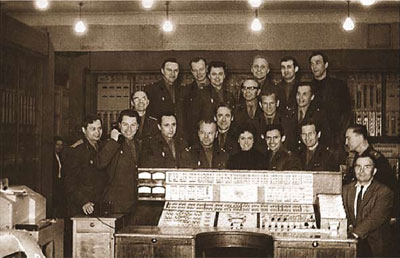Russian Virtual Computer Museum. → Hall of Fame → Role of Computer Centre №1 of the USSR Ministry of Defence in the beginning Period of Space Explorations
Role of Computer Centre №1 of the USSR Ministry of Defence in the beginning Period of Space Explorations
Home → Hall of Fame → Kitov Anatoliy Ivanovich → Role of Computer Centre №1 of the USSR Ministry of Defence in the beginning Period of Space Explorations”
Isaev Vladimir Petrovich
In May-June 1954 Computer Centre №1 (CC-1) -another name Central Scientific Research Institute 27 (CSRI-27), the first computer centre in the country, was founded at the USSR Ministry of Defence on the initiative of Anatoliy Ivanovich Kitov. During the next six years (1954-1960) A.I. Kitov – its creator, was not only its scientific leader but also the de facto head of it. He planned it to be a powerful and the most important place for performing calculations with the use of the most modern and powerful (for that time) digital electronic computing means (such as the first serial computer STRELA). Those computations, which included solving of the missile and space problems, should be done to meet the needs of the armed forces.

Anatoliy Ivanovich Kitov, founder of the USSR first computer centre (CC-1) at the Ministry of Defence, 1954.
Professor of the Academy of Military Sciences colonel-engineer A.Ya. Prikhodko remembers details of that -the latter- significant, however, unreasonably forgotten work. In 1980-2000 he himself was serving at the CSRI-27.
His article “A.I. Kitov – the founder of military informatics in the USSR”, was published in the book “Anatoliy Ivanovich Kitov – a pioneer of informatics, cybernetic and automated control systems”. There he writes the following: “Nowadays, there are just few ones who know that the CC-1 of the Ministry of Defence performed calculations of all ballistic problems for creating the first Soviet satellites, and later for the first four manned space flights. This page of the Soviet cosmonautics history is still closed, although without solving those problems launching of intercontinental ballistic rockets would be impossible”.
Actual director of the CSRI-27 /CC-1 A.A. Protasov also confirms this fact. Thus, he writes in the magazine “Military Thought” №7 2009), “Already by the end of 1955 the Centre (CC-1) grew to the level of scientific organization, being able for performing serious researches for the needs of our national defence. That was basically due to successful mastering the first Soviet electronic digital computers and quick preparation of the first highly professional specialists on programming“.
“The works of 1956 formed solid basis for realization of the long-range ballistic missiles launching programs, also launching of the first satellites and, later, for the programs of manned space flights and flights of automated stations to the planets of our solar system. The work on maintaining the flights of Y. Gagarin, G. Titov, A. Nikolaev and P. Popovich were the Centre's significant contribution to the space explorations”.
Indeed, remembering that time I can claim that the CC-1 was both unique and ideal organization for making military computations and various ballistic calculations for the beginning national cosmonautics. That had been determined by a number of specific factors of those times.
To begin with, there was an urgent need to prepare big contingent of highly professional officers for maintaining combat readiness and reliable operation of new Soviet strategic missile-forces.
An unprecedented step was made for that purpose. In 1952-1953, by several joint decisions of the USSR Central Party (communist) Committee and the USSR Council of Ministers (supreme bodies of power) some best students (about a thousand) of the last pre-graduate year, from the country's leading technical universities, were invited to join the armed forces. There they should continue, for one-and-half more year, and complete their education at the (Moscow) military engineering F.E. Dzerzhinskiy Artillery Academy. That action was famous under the name “special conscription”. The “former students” received appropriate qualification in ballistics, rocket launching, missile flight trecking, rocket engines operation and other at the newly established faculty. The faculty head - Lieutenant general A.I. Nesterenko was a veteran of the World War Two. At the war time he was a commander of a unit of mobile rocket-launchers (legendary Katyusha rocket-launcher); after the war he became a director of the (Moscow) Scientific Research Institute №4 (military electronics).
After graduation the future missile-force officers joined new army units of strategic missile-force where rockets were prepared for launching. They also worked at the land-based flight tracking stations all over the country, as well as in all other parts of the complex chain of actions aimed at maintaining reliable operation and development of the national rocket and space engineering.

Presidium of the CC-1 solemn meeting dedicated to the 40 years jubilee of the Great October Revolution. A.I. Kitov is the first on the left; 1957.
Students of the Moscow Power Engineering Institute - MPEI (mainly from the faculty of special instrumentation) came from the Academy as lieutenant-engineers - experts on the missile on-board control systems.
The first group graduated in June 1954. Besides learning at the Academy itself the students did practical training at military organizations in Kharkov, Dnepropetrovsk and at the USSR first rocket launching field.
In 1952-1953, a small group of students [1] of the MPEI faculty of electronic vacuum instruments had studied there special course “Digital Electronic Computers”, already before entering the Academy. Academician Sergey Lebedev – the founder of the Soviet digital electronic computers, was our lecturer and he also conducted practical studies with us. That was why both the group and the author were already qualified specialists in that, absolutely new and unfamiliar for most of others, computer field. When A.I. Kitov, who then headed the computer department at the Artillery Academy, received permission for establishing the country's first computer centre – CC-1, of the USSR Ministry of Defence, he simultaneously initiated permission to take some students-graduates from our “special course” (for needs of the CC-1).
Quite naturally, he first took those who came from the MPEI already as qualified computer users. Finally, Kitov invited twelve graduates altogether, among them there were three of us – “the experts”. Most of others formerly were also the MPEI students.

Monument to the first man-made satellite of the Earth.
Thus, each of those graduates – young lieutenants-engineers had two very important specialties, they were experts in both rocket engineering and instrumentation, in automatic devices and computers.
All officers from the Academy's computer department, about twenty people, also joined the CC-1. They were mainly rocket experts, many of them were the war veterans, some even had experience from earlier working at the first experimental rocket launching field. I mean by this, that the new scientific team was well enough prepared both for the work with computers and for cooperation with rocket and space specialists from the Scientific Research Institute №4 (SRI-4) of the USSR Ministry of Defence, Experimental Design Bureau-1 and other organizations.
Another essential factor was the chief of the CC-1 A.I. Kitov himself. Not long before that, in 1952, he successfully defended dissertation (for the “candidate of sciences” degree) titled „Programming in the problems of long range missiles exterior ballistics“. That was the first dissertation on computer programming in the USSR. His defending of the dissertation took place at the Scientific Council of the SRI-4 – principal centre of the national rocket and space ideas and science. Therefore, the basis for scientific cooperation had been formed.
Military secrecy status of our organization was also a serious factor, which made performing computations for the space-engineering and research tasks at the CC-1 very convenient.
Thus, not only the computer itself (which, by the way, was also classified), but also the whole team, including the assistants and service personnel, had to have special personal permissions for working with the secret subjects and classified documentation.
Of course, it is self-evident that all working positions of programmers and of electronic engineers whom we nicknamed “the engineers” (what has one more meaning – “machine man / locomotive driver”) were occupied by the regular officers–specialists.
Well, those were the reasons why our CC-1 was very convenient and efficient for making calculations on rocket and space tasks (naturally classified) by the collaborators of SRI-4 and those from other similar organizations.
One more reason was rather simple: to tell the truth, there was no other similar organization in the country. Those years our CC-1 was THE ONLY centre of such kind and level.
At the same time, in 1954-1960, the situation at the Scientific Research Institute No 4, on my opinion, was quite opposite. Quite paradoxically, an institute of such scientific level and of so high importance for the state defence, had neither own computer centre nor any computers at all.
However, then its design bureaus and laboratories were engaged in intensive research and development of rockets; satellites were designed and the preparations for orbital space flights were active. Anyway, such things happen sometimes.
Unbelievable, but true fact. In spite of all difficulties the work of powerful scientific and engineering teams of the institute was very efficient and successful. All over the country's territory a huge network of flight tracking stations and centres was established (along all possible space objects' flight trajectories); they all were connected with communication channels. However, the computing group of the SRI-4 calculated trajectories of flights on... logarithmic rules.
And the precession of their calculations was very, very high. Fantastic thing!
Of course, both the Experimental Design Bureau -1 and SRI-4 badly needed their own computer centre, and the powerful one, which would make all necessary computations quicker, reliably and with still higher precession. Nevertheless, the own computer centre of the Scientific Research Missile Institute №4 (SRI-4, when founded in 1946) was established only in 1959, and it started regular work a year and half later. It was equipped with two digital electronic computers M-20 produced by the Moscow computer plant SAM (САМ). M-20 were some more advanced than STRELA; academician S.A. Lebedev was their chief designer.
All time before it was in operation, all complex calculations (such as trajectories of space objects orbits, calculations of the designed components, manned spaceships and big range of other problems and computations) specialists of the SRI-4 made at the CC-1 of the Ministry of Defence, regularly arriving there with their materials.

Building of the CC-1 of the USSR Ministry of Defence; Moscow.

Computer STRELA; control panel. Major V.P. Isaev (the author) is the first on the right.
As mentioned before, I started my military service at the CC-1 at the moment of its creation – June 1954. Due to my education, previous training and experience I was appointed as a senior engineer, and soon after was promoted to a senior shift-head of computer STRELA programming and maintenance team. Here we should not give detailed description of that the USSR first serial computer, parameters of its huge machine rooms, auxiliary equipment, etc. All that is very well displayed in computer literature and numerous other sources. Here I present only a photo of the STRELA team collaborators at its main control panel.
Main task of our “engineers” consisted in permanent maintaining the computer in good operating condition, which, however, was sometimes interrupted for various reasons. We were working in shifts, while our STRELA did not have rest. By the way, such operating mode was better for it – there were much fewer failures and malfunctions.
Quite naturally the shift-head was always and fully responsible for everything in regard to the computer (for its operation, for peripheral -rather unstable- devices, for the maintaining personnel actions and mistakes, etc., etc.). To be answerable to the third-party contractors was even more difficult. And no need to say, how much stress caused responsibility before customers of the state-level importance.
Thus, the specialists from the SRI-4 usually arrived with their tasks at high, what had several reasons. On one hand, our experience proved that there were much less multiple or even single failures in computer operation at that time. On the other hand, it was easier to follow all secrecy regulations and demands while working in night shift.
It should be specially pointed that maintaining the secrecy of computations was much more complicated problem than it could look for an outside observer. Despite the so-called “internal secrecy regulations”: personal admittance-access-working permissions for each collaborator, well-organized strict enumeration, recording and control of everything, special rules for materials and computer input-output data carriers storage (punch-cards, magnetic tapes, printed computation results, etc.) and some other safety and secrecy precaution measures there always remained one more, so-called “external” factor.
“External factor” means the “outer leakage” of information in form of electromagnetic radiation (electromagnetic signal leakage) during computer operation. Then there did not yet exist special USSR State Technical Commission, which later issued appropriate demands for designers of special-purpose computers, which should be mounted at classified computer centres for solving the problems of “secret type” there; (those works were also called “of closed character”).
In the beginning we did not think about that; therefore, we didn't take any protective measures. However, one day a duty officer of the computer centre suddenly noticed an unknown car directly at the main entrance to our building. One of its windows was open and unusually looking radio antenna of right-angle shape was moved out of it. Unfortunately he could not clear up anything; the car speeded away (as soon as somebody inside noticed his close attention?). The officer immediately informed the computer centre administration about that. After consultation with some competent organizations some organizational measures were taken. New fence was erected around the building and all adjacent peripheral territories were constantly monitored. Nevertheless, it was very difficult to control all suspicious cars passing by at the day-time. Therefore, especially secret tasks, first of all solving of missile and space problems, should be performed at nights. At the same time some special cars from a Military Auto Inspection station (on special agreement with CC-1) were called to patrol the near-by streets.
The same “methods” were adopted and implemented in the building of Main Computer Centre of the USSR State Planning Committee (Russ. Gosplan), when they were making calculations for national military and economic plans. They could do it efficiently, also because our former collaborators – officers Y.I. Bezzabotnov, N.A. Krinitskiy, L.N. Kutsev and some others, worked at that centre and headed it.
Thus, the specialists of SRI-4 and other organizations visited our CC-1 to perform computations for their rocket and space problems, because that was an optimal variant for that time, and they were sure of that.
Of all our numerous visitors the meeting with a remarkable person – scientist, designer and a cosmonaut K.P. Feoktistov2made the biggest impression on me. He became the first man in history who performed space-mission on the ship which he designed himself. That was the flight of space ship “Voskhod” manned with three cosmonauts, in October 1964. Konstantin Feoktistov made very many computations at our CC-1; among other he calculated orbits of the first satellite (“Sputnik”).
Collaborators of the CC-1, such as “engineers”, programmers, officers problem-analysts, also the special group of so-called “first department” (secret service, which received, stored and checked-out the secret documents and computer output materials), all of them did their best to provide necessary assistance and support for their colleagues from the SRI-4.
Of other SRI-4 specialists I remember A. Simonyan (later he came to work at our CSRI-27), O. Vasilkevich, V. Mitrikhin and some other colleagues. Most of them calculated space orbits with the use of differential equations of exterior ballistics, which were worked out at the SRI-4.
All that is very well described by my mate at „special conscription“, doctor of technical sciences, professor G.A. Mironov in his memoirs. He also served at the CC-1 from the moment of its establishing.
Mironov remembers that in 1956 and in some following years, researches and practical development performed under supervision and also with active personal participation of A.I. Kitov made contribution to realization of satellites launching programs. They also formed basis for the later flights of the first manned spaceships. Provision of all necessary assistance for rocket and space calculations including priorities at computer service, introducing convenient for such customers changings into working schedule of the CC-1 secret group and other similar tasks, were given to us by the CC-1 administration and personally by A.I. Kitov. In fact that was he, who communicated with third-party customers of our computer time; he also defined their priorities. The author always remembered that.
I think that celebrating jubilees of the space mission of our countryman Yuri Gagarin – the first cosmonaut in the history of humankind, we should also remember and pay tribute to the collaborators of the CC-1 for performing all necessary computations, which became their contribution to common efforts on the threshold of the space age.
For the conclusion I should also say that mentioning here the names of all those who did the best to assist our cosmonautics in its beginning - formation period is my moral obligation as of their colleague and friend.
They are: A.I. Kitov, B.N. Abramov, R.S. Andreeva, V.P. Bityutskiy, N.P. Buslenko, A.M. Bukhtiyarov, G.N. Golofeevskaya, G.A. Mironov, G.G. Ovsyannikov, S.A. Ponomareva, G.B. Smirnov, A.M. Sukhov, B.S. Trifonov, Y.G. Uvarov and many others...
Even many years after it is not easy to correctly evaluate real amount and scientific level of computations in the field of rocket engineering and cosmonautics development, including my own contribution, that were done that time. The “curtain of secrecy” around our work was very dense. However, the fact is – the four years of regular work with computers at the CC-1 of the USSR Ministry of Defence speak for themselves – and tell a lot.
I am sure that contribution of the CC-1, of its leader A.I. Kitov and the whole team of its collaborators to development of our national Cosmonautics and space explorations was essential and significant.
It was also timely and, for that reason, actually important; we – its veterans, have right to be proud of that.
Notes.
1.The author was one of them (A.N.)
2. https://en.wikipedia.org/wiki/Konstantin_Feoktistov
Edited and translated by Alexander Nitusov
Published in museum, 31.03.2016



